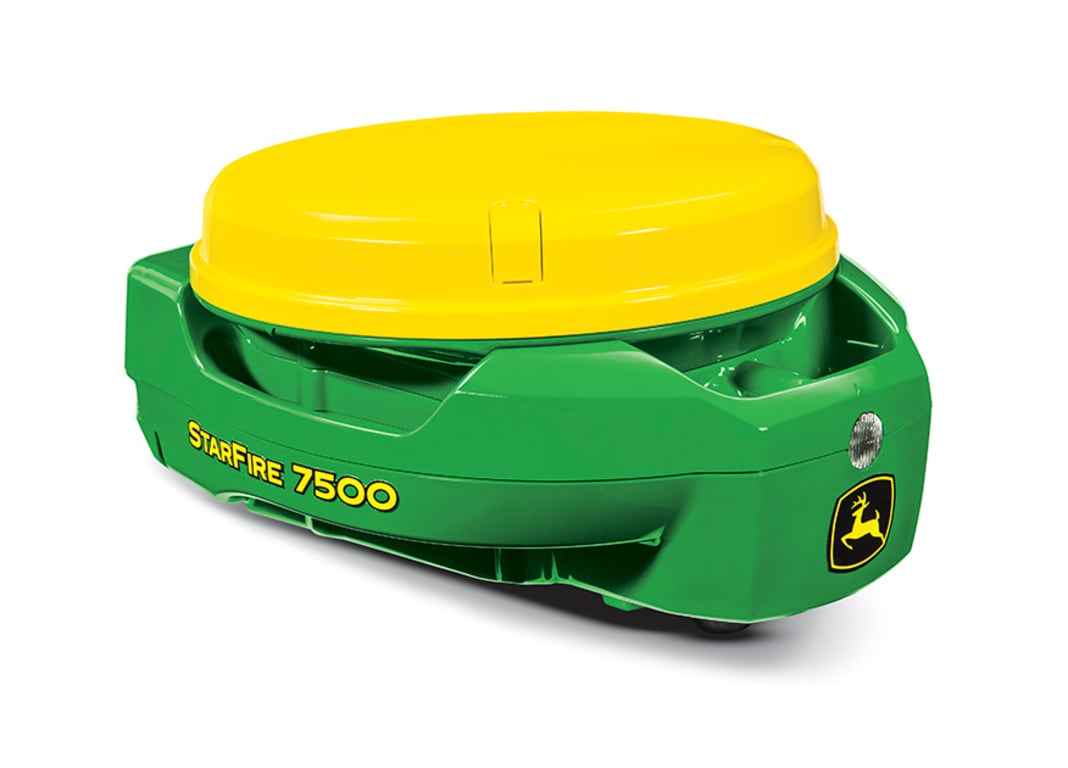
StarFire™ 7500 Receiver
with SF-RTK Signal
- RTK-like accuracy – 2.5 cm pass to pass accuracy
- SF-RTK achieves 73% faster pull-in times1, compared to SF3 signal
- Long-term repeatability, season to season
- Drop-in replacement for StarFire™ 6000 Receiver
Features
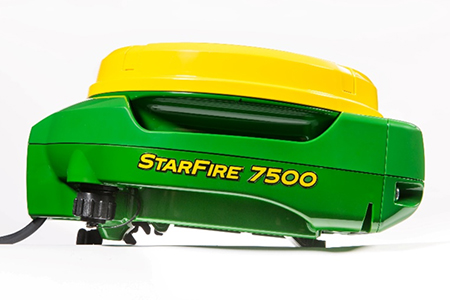 StarFire 7500 receiver
StarFire 7500 receiver
When it comes to large agricultural, small agriculture and turf customers, the StarFire 7500 receiver is precise – allowing for repeatable placement of machines, fertilizer, seed, and herbicides.
- 100 percent increase in satellite constellations used by the receiver*
- 17 percent greater accuracy*
- Long-term repeatability (where applicable) vs. 9 months*
- 73 percent reduction in pull-in time*
- Universal offering that’s compatible with older and competitive equipment
- Interchangeable: tillage, planting, spraying, and harvesting
*All comparisons made to the StarFire 6000 with SF3
 StarFire™ 7500 Receiver
StarFire™ 7500 Receiver
The StarFire 7500 Receiver offers a new correction level with accuracy like RTK Radio. The SF-RTK correction level provides 2.5-cm (1-in.) horizontal accuracy without the need for additional hardware. This is an improvement of 17 percent from the previous generation of StarFire receiver with SF3. The SF-RTK signal uses two additional satellite constellations (BeiDou and Galileo) as well as both GPS (United States) and GLONASS (Russia) satellites.
The StarFire 7500 and StarFire 7500 Integrated Receivers simultaneously track correction signals from up to three StarFire correction satellites. The receiver tracks and uses correction signals from all StarFire satellites in view and intelligently chooses one that delivers the best performance. When the receiver moves into an area where the primary StarFire signal is blocked, such as near a tree line, the receiver automatically switches to an alternate StarFire signal (if visible) to help maintain accuracy and performance.
NOTE: Compare this to the previous StarFire 3000 Receiver that was only capable of tracking one StarFire signal at a time and could wait up to 4 minutes to initiate the switch to the next available signal.
Repeatability defines how accurately the receiver calculates its position over a relatively long-term window.
NOTE: SF-RTK uses satellite corrections only and does not require the use of an RTK Radio. RTK Radio may still be required in the following scenarios:
- iGrade™ water management
- Areas with thick tree lines or obstacles that could cause shading of the receiver
- Long-term repeatability in countries we cannot guarantee SF-RTK repeatability (see list under SF-RTK repeatability)
- Land leveling
John Deere’s latest satellite correction offering provides customers with simplified access to Radio RTK like accuracy and repeatability. Prior to SF-RTK, customers had to purchase additional hardware, RTK Ready or Permanent Licenses, and in most use cases work with a local John Deere dealer to access their base station network to use Radio RTK.
SF-RTK eliminates that complexity through offering the same level of accuracy and repeatability from the sky! Plus, with SF-RTK there’s no need to switch base stations when moving between fields like seen with Radio RTK.
What does SF-RTK do?
The StarFire 7500 utilizes four GNSS satellite constellations, which are corrected through John Deere’s StarFire network to provide sub-inch horizontal accuracy. This provides customer’s our highest accuracy level, along with long-term repeatability (where applicable) to enable advanced guidance features and the confidence that guidance lines and boundaries won't shift from year to year.
Why should customers use SF-RTK?
Customers are continually looking for simplified solutions that deliver the value needed for their operation. SF-RTK offers a lower cost of entry for customers compared to Radio RTK, making this solution an easy decision for customers looking to use a high precision correction signal. Why pay for additional hardware, permanent licenses and base station access fees when SF-RTK only requires a yearly license to operate on your StarFire 7000 or StarFire 7500 receiver.
SF-RTK vs. Radio RTK vs. Mobile RTK (on a StarFire 7500)
Requirements to use SF-RTK
- StarFire 7500 Receiver
- SF-RTK 1-year license
Requirements to use Radio RTK
|
Requirements to use Mobile RTK (through 4G LTE Modem). Availability limited to select countries.
|
Choosing the right correction mode
|
SF1 |
SF-RTK |
RTK |
Documentation |
X |
X |
X |
AutoTrac™ automated steering |
X |
X |
X |
Section Control |
X |
X |
X |
| Overlap control | X | X | X |
AutoTrac RowSense™ system |
X | X | X |
AutoTrac Turn Automation |
--- | X | X |
AutoTrac Vision guidance |
--- | X | X |
Machine Sync |
X | X | X |
In-Field Data Sharing (guidance lines sharing) |
--- | X | X |
AutoPath™ software |
--- | X | X |
AutoTrac Implement Guidance |
--- | X | X |
Land leveling |
--- | --- | X |
Many factors contribute to the time it takes to achieve desired accuracy from the StarFire™ receiver. Global Navigation Satellite System (GNSS) signal quality can be a contributor, especially when multipath errors occur. Multipath errors occur when satellite signals reflect off nearby surfaces. When the receiver antenna captures a multipath signal, it takes time for the receiver to filter out actual GNSS signal directly from the satellite versus reflected signal from a nearby object. This contributes to the time it takes to achieve desired accuracy.
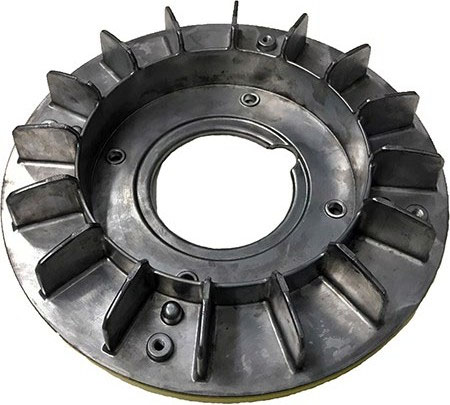 Choke plate
Choke plate
The choke plate hardware in the StarFire 7500 Receiver more accurately directs GNSS signals into the antenna. With the addition of this choke plate, there is a 73 percent reduction in the time it takes to acquire an SF-RTK correction signal from previous generations of StarFire receivers. This means you have more time to be productive and get the job done quicker.
The StarFire 7500 and StarFire 7500 Integrated Receiver use an integrated terrain compensation module (TCM) to adjust the calculated machine position based on the terrain on which it is operating. The TCM adjusts for roll, pitch, and yaw motion to improve receiver and AutoTrac™ system performance when operating in challenging conditions such as hilly ground.
- TCM ensures accurate Section Control and AutoTrac guidance performance.
- TCM provides input data such as pitch to systems like the ActiveYield™ monitoring system on combines.
- The StarFire 7500 Integrated Receiver comes factory calibrated, ensuring the highest possible performance and precision.
Advanced TCM Calibration
As accuracy and repeatability continue to be more important to get to plant-by-plant accuracy, the systems in place today must evolve to enable this capability. Like the StarFire 6000 and StarFire 7000, the StarFire 7500 offers an Advanced TCM Calibration feature.
Benefits:
- Removes the guesswork out of positioning a machine and implement in the exact same spot when turning around.
- Removes the need for a level surface.
- Adds higher precision to the TCM calibration by gathering and comparing multiple points.
- Calibrates both the machine and implement receiver TCM at the same time.
How it works:
- Roughly 100.6 m (330 ft) of space is required for the calibration.
- During the calibration, speed should not exceed 6.4 km/h (4 mph).
- If an error occurs during the calibration, the operator is notified.
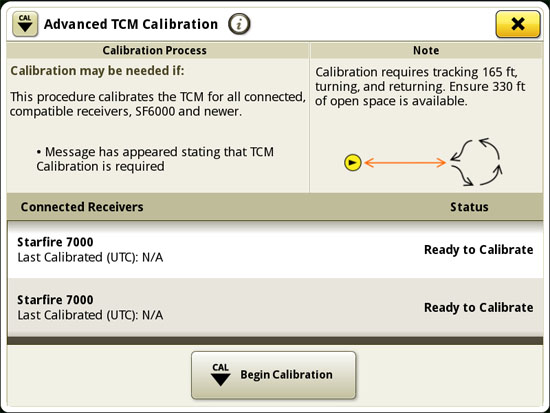 Advanced TCM Calibration page in the display
Advanced TCM Calibration page in the display
- Select Advanced TCM Calibration from the device list in the display.
- Follow the on-screen prompts to set up a guidance line.
- Drive the guidance line using AutoTrac automated steering from point A to point B.
- Manually turn and resume AutoTrac steering, driving the guidance line back to point A.
This completes the calibration.
Compatibility:
- StarFire 7500 Receiver or StarFire 7500 Integrated Receiver
- StarFire 7000 Receiver or StarFire 7000 Integrated Receiver
- StarFire 6000 Receiver or StarFire 6000 Integrated Receiver with software update 20-2 or later
- G5 or G5Plus CommandCenter™ Displays G5 or G5Plus Universal Displays
- Gen 4 4600 CommandCenter Display with software update 20-3 or later
- Gen 4 4640 Universal Display with software update 20-3 or later Must have an AutoTrac activation
With Ethernet connectivity on the StarFire 7500 Integrated Receiver, you can save up to 60 minutes per year while performing over-the-air software updates to keep your technology in sync with the latest features
With the StarFire™ 7500 Receiver and SF-RTK correction level, you can have confidence from year to year that your guidance lines and boundaries will stay where they need to be.
StarFire 7500 and StarFire 7500 Integrated repeatability:
- SF1: no repeatability, position drifts over time
- SF-RTK: +/- 2.5-cm (1-in.) long-term repeatability (where applicable, see above SF-RTK repeatability section)
- SF-RTK repeatability claims are only valid after the receiver has completed a full pull-in and is operating at 100 percent accuracy.
- RTK Radio: +/- 2.5-cm (1-in.) long-term repeatability
- RTK Radio repeatability specifications are based on a properly installed RTK base station and a base station position that has not been modified after initial setup.
NOTE: Repeatability may be impacted by large unpredictable geological events such as earthquakes.
Value of repeatability
Repeatability defines how accurately the receiver calculates its position over a relatively long timeframe. Repeatability is measured at the receiver and does not take into account additional error sources such as AutoTrac™ control system error, ground conditions, or implement drift.
In-season repeatability is critical when using AutoTrac for multiple jobs throughout the growing season, such as creating AutoTrac guidance lines during planting, then using those same guidance lines to complete subsequent jobs like side dressing fertilizer, post-emerge spraying, and harvesting.
Long-term repeatability is critical when mapping interior and exterior boundaries for later use as input to John Deere Section Control on planters, sprayers, and fertilizer applicators. It is also critical for growers that use the same AutoTrac guidance lines over multiple seasons for operations like subsurface-drip irrigation, controlled traffic, or alternating planter spacing between the rows from a previous season.
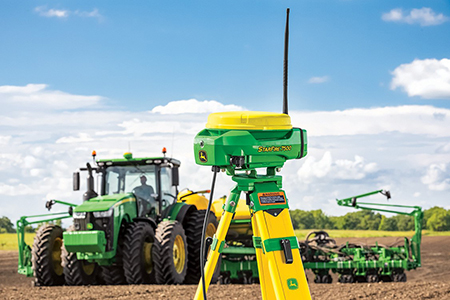 StarFire™ 7500 Receiver
StarFire™ 7500 Receiver
- Better accuracy and more reliable RTK
- Fast startup and shading recovery times, less line jumps, and more reliable performance under shading environments
- Better RTK-X performance compared to StarFire 6000 or StarFire 3000 Receiver base
- Vertical accuracy improvement
NOTE: Data collected when running a StarFire 7500 Receiver base with a StarFire 7500 rover.
NOTE: RTK Radio still requires the use of a compatible radio.
Drop-in replacement
As John Deere continues to advance their technology, the StarFire™ 7500 receivers are designed with modular components, making the unit a drop-in replacement for the previous generation of integrated receiver. You never have to worry about having outdated hardware.
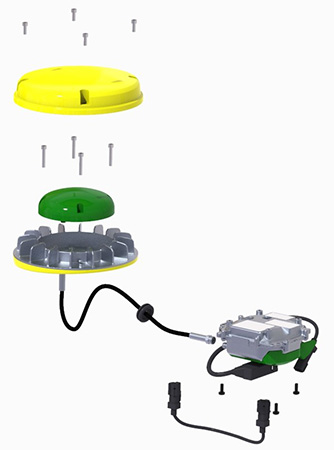 StarFire 7500 Integrated Receiver
StarFire 7500 Integrated Receiver
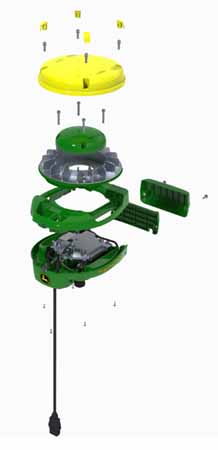 StarFire 7500 Universal Receiver
StarFire 7500 Universal Receiver
Serviceability
The StarFire 7500 Universal Receiver has more than 20 parts that are completely serviceable. In the unlikely event that there is a problem with the system, many of the individual components can be replaced without replacing everything. This saves you time and money that can be used in other areas of your operation.
Shared signal enables the pairing of two receivers and facilitates communication between them to improve relative system accuracy when utilizing AutoTrac™ Implement Guidance (ATIG), Active Implement Guidance™ (AIG), Machine Sync, or AutoPath™ (AP) advanced software via the following displays:
- G5 or G5Plus CommandCenter™ Displays
- G5 or G5Plus Universal Displays
- Gen 4 4600 CommandCenter Display
- Gen 4 4640 Universal Display
- GreenStar™ 3 2630 Display
Supported configurations:
The following receivers are compatible with shared signal and can be used interchangeably.
- StarFire™ 7500 Receivers
- StarFire 7000 Receivers
- StarFire 6000 Receivers*
- StarFire 3000 Receivers*
*A known conflict exists for the following configuration:
- StarFire 6000 with SF3 on the tractor
- StarFire 3000 on the implement, using shared signal
If customers are using this configuration, please submit a DTAC case to validate the data recorded in the source operation and allow that data to be used for AutoPath.
IMPORTANT NOTES:
When using shared signal, the system matches the correction signal from the leader, so the leader must have the higher correction level. The follower may have a lower correction level, but the overall system accuracy will reflect that of the leader. This is applicable for AutoPath and Machine Sync operations.
Leader Examples: The tractor running ATIG, AP, or AIG, or the combine/pull-type harvester using Machine Sync.
Follower Examples: The implement that is part of an ATIG, AP, or AIG operation, or the grain cart tractor in a Machine Sync operation.
- StarFire 6000 Receivers must be updated to 20-2 (4.40N)
- StarFire 3000 Receivers must be updated to 20-2 (2.80S)
Machine Sync
To ensure optimal performance and compatibility, always update receivers to the most current software version available on the StellarSupport™ portal. The following table describes the accuracy expected from this system:
Leader receiver activation level |
Follower receiver activation level |
Overall system accuracy level |
Machine Sync Compatible |
SF-RTK/SF3/SF2 |
SF1 |
SF-RTK/SF3/SF2 |
Yes |
RTK |
SF1 |
RTK |
Yes |
RTK |
SF-RTK/SF3/SF2 |
RTK |
Yes |
SF-RTK/SF3/SF2 |
RTK |
SF-RTK/SF3/SF2 |
Yes |
SF1 |
RTK |
SF1 |
Yes |
Mobile RTK Signal* |
SF1/SF2/SF3/ |
RTK |
Yes |
*John Deere Mobile RTK currently only available on StarFire 6000 and StarFire 3000 receivers.